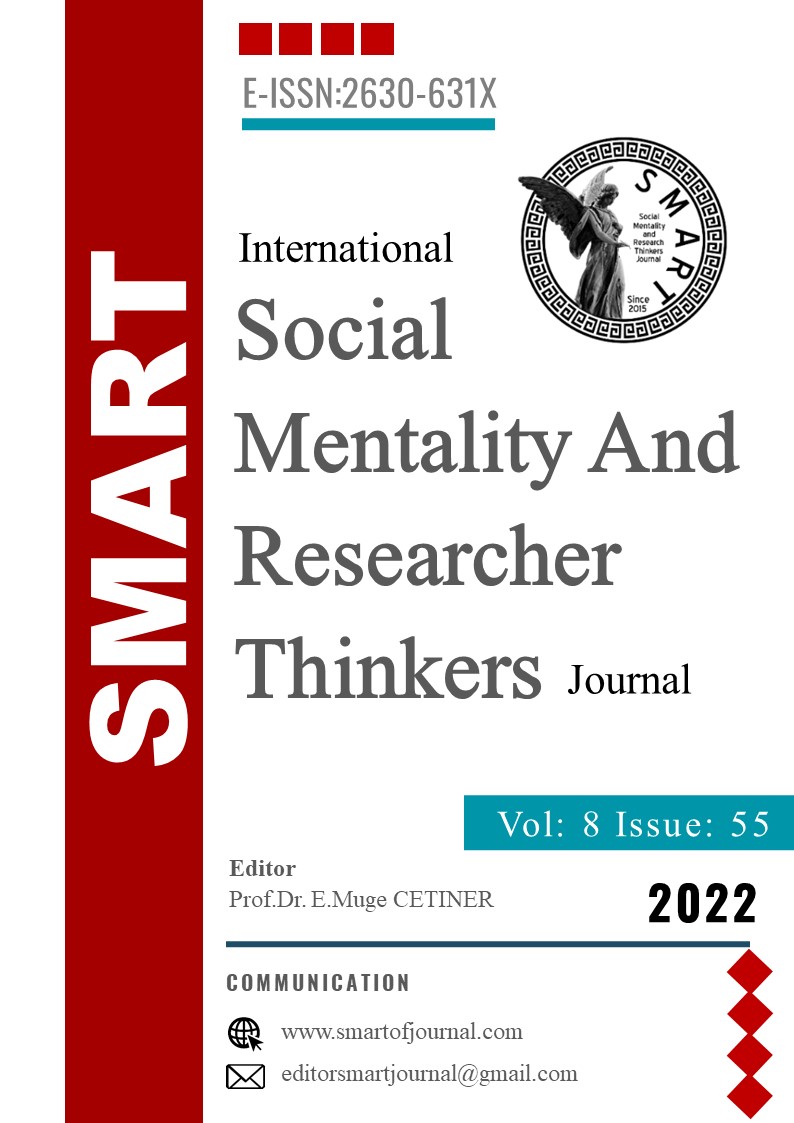Author :
Abstract
İnsanoğlu yüzyıllar boyunca yaşadığı süreç içerisinde, doğrudan ve dolaylı olarak bir takım atıkların oluşmasına sebep olmuştur. Söz konusu olan bu atıkların zaman içerisinde niceliksel miktarında ciddi bir artış meydana gelmiştir. Özellikle küreselleşen dünya ile birlikte, tarım toplumundan sanayi toplumuna geçiş, ortaya çıkan atıkların doğada çözülebilmesini olumsuz anlamda etkilemiştir. Bu etkinin oluşmasında en önemli faktörlerden biri, seri üretime dayalı olarak ortaya çıkan ürünlerin sayısal çokluğuyla ilintilidir. Nitekim günümüzde devletlerin en büyük problemlerinin arasında atık yönetimi meselesi yer almaktadır. Bahsi geçen mesele-konu yalnızca devletler nezdinde değil, tüm insanlığın, toplumların, grupların, kitlelerin de ilgi odağı durumundadır. Bu ilgi, hiç şüphesiz birçok disiplinde de konu olarak ele alınmaktadır. Sanat da bu disiplinlerden biridir. Zira çevresine yüksek farkındalık ve duyarlılıkla bakıp, gördüklerini sanata taşıyan sanatçı, atık nesneleri de konu olarak ele almıştır. Bu çalışmada da benzer duyarlılığa sahip olan bir sanatçının atık nesneleri ele alış biçimi üzerinde durulmuştur. Metot olarak nitel araştırma yöntemlerinden durum çalışması deseni ile şekillenmiş olan çalışma, üç temaya sahiptir. Bu temalar; atık nesneler, farkındalık ve duyarlılık, estetik kaygı olmak üzere adlandırılmıştır. Araştırma neticesinde, kişinin sosyal yaşamında rahatsızlık duyduğu durumları [doğaya ve insanlığa zarar veren atık nesneler] sanatla ilişkilendirerek bir takım yorumlamalara gittiği görülmüştür.
Keywords
Abstract
In the process that mankind has lived for centuries, it has caused the formation of some wastes directly and indirectly. There has been a significant increase in the quantitative amount of these wastes over time. Especially with the globalizing world, the transition from agricultural society to industrial society has negatively affected the decomposition of the resulting wastes in nature. One of the most important factors in the formation of this effect is related to the numerical multiplicity of the products based on mass production. As a matter of fact, one of the biggest problems of states today is the issue of waste management. The aforementioned issue-subject is not only the focus of attention of states, but also of all humanity, societies, groups and masses. This interest is undoubtedly addressed as a subject in many disciplines. Art is one of these disciplines. Because the artist, who looks at his environment with high awareness and sensitivity and carries what he sees to art, also deals with waste objects as a subject. In this study, the approach of an artist who has a similar sensitivity to waste objects is emphasized. The study, which is shaped by the case study pattern, which is one of the qualitative research methods, has three themes. These themes are; waste objects, awareness and sensitivity, aesthetic concern. As a result of the research, the situations in which the person is uncomfortable in her social lifIt has been seen that she made some interpretations by associating [waste objects that harm nature and humanity] with art.
Keywords
- Akar, H. (2017). Durum çalışması. (Ed. A. Saban ve A. Ersoy.), Eğitimde Nitel Araştırma Desenleri, s. 139-
- Akar, H. (2017). Durum çalışması. (Ed. A. Saban ve A. Ersoy.), Eğitimde Nitel Araştırma Desenleri, s. 139- 176, Anı Yayıncılık, Ankara.
- Aydoğan, Y. (2020). “Kültürel Miras Bilinci Kazanımıyla İlgili Müze Eğitimi Dersi Üzerine Bir Durum Çalışması”, Doktora Tezi, Anadolu Üniversitesi Eğitim Bilimleri Enstitüsü, Eskişehir.
- Baltacı, A. (2019). “Nitel Araştırma Süreci: Nitel Bir Araştırma Nasıl Yapılır?”, Ahi Evran Üniversitesi Sosyal Bilimler Enstitüsü Dergisi, 5- 369.
- Bingöl, P. M. ve Çevik, N. (2020). “Çağdaş Sanatta Bir İfade Unsuru Olarak Kolaj Üzerine Bireysel Söylemler”, Adıyaman Üniversitesi Sosyal Bilimler Enstitüsü Dergisi, 13- 36.
- Ersoy, A. (2002). Sanat Kavramlarına Giriş, Yorum Sanat Yayıncılık, İstanbul.
- Gökçe, S. (2015). “Sanatsal Yaratma Sürecinde Estetik Kaygının İşlevi”, Yüksek Lisans Tezi, Pamukkale Üniversitesi Eğitim Bilimleri Enstitüsü, Denizli.
- Karataş, Z. (2015). “Sosyal Bilimlerde Nitel Araştırma Yöntemleri”, Manevi Temelli Sosyal Araştırmaları Dergisi, 2015/1-66.
- Manastırlı, R. (2017). “Hazır Nesnelerin Sanatsal Formlara Dönüşüm Süreci”, Yüksek Lisans Tezi, Yakın Doğu Üniversitesi Sosyal Bilimler Enstitüsü, Lefkoşe (Kıbrıs)
- Öznülüer, H. (2019). Atık Nesnelerin Resim Sanatına Girişinde Picasso ve Braque'nin Etkisi, Uluslararası Sosyal ve Beşeri Bilimler Araştırma Dergisi, 2019- 699.
- Sağlam, F. (2016). Atık Nesnelerin Sanatta ve Sanat Eğitiminde Kullanılmasına Yönelik Öğretim Elemanlarının Görüşleri, Uluslararası Eğitim Bilimleri Dergisi, 8- 247.
- Sağlam, F. (2019). “Resimde imge Olarak Endüstriyel Atıklar”, Yüksek Lisans Tezi, İnönü Üniversitesi Sosyal Bilimler Enstitüsü, Malatya.
- Sağlam, F. ve Enginoğlu, T. (2016). Sanat Nesnesi Olarak Atık Nesne, Batı Anadolu Eğitim Bilimleri Dergisi, 07(14), 47-49.
- Saygı, S. (2016). Çağdaş Sanatta Doğa Algısı Ve Ekolojik Farkındalık, Sanat-Tasarım Dergisi, (7), 7-13
- Subaşı, M. ve Okumuş, K. (2017). Bir Araştırma Yöntemi Olarak Durum Çalışması, Atatürk Üniversitesi Sosyal Bilimler Enstitüsü Dergisi, 2- 420
- Taghisoğlu, R. (2020). “Nitel Bir Araştırma Tekniği Olarak: Durum Çalışması”, Yüksek Lisans Tezi, Selçuk Üniversitesi Sosyal Bilimler Enstitüsü, Konya.
- Thomson, G. (1987). İnsanın Özü, (Çev. Celal Üster), Payel Yayınevi, İstanbul.
- Türkdoğan, G. (2017). “İnsan Doğa İlişkisi Bağlamında 1960 Sonrası Sanatta Doğaya Yönelimler”, Yüksek Lisans Tezi, Anadolu Üniversitesi Güzel Sanatlar Enstitüsü, Eskişehir.
- Türksoy, Ö. (1991). Çevre Duyarlılığı Eğitiminde Bilişsel Yaklaşım: Çocuk ve Temel Çevre Özellikleri, 16.





